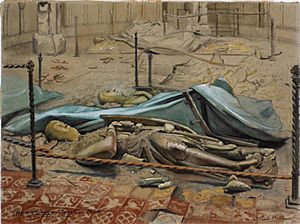Norma Bull facts for kids
Quick facts for kids
Norma Bull
|
|
|---|---|
| Born | 7 September 1906 |
| Died | September 1980 Melbourne
|
| Nationality | Australian |
| Education | National Gallery of Victoria Art School |
| Known for | Painting, drawing |
Norma Catherine Bull (born September 7, 1906 – died September 1980) was a talented Australian artist. She was known for her paintings, prints, and etchings. Norma Bull became famous for the artworks she created in Britain during World War II.
Early Life and Art Training
Norma Bull grew up in Melbourne, Australia. Her father worked at the University of Melbourne. In 1932, she finished her studies at the National Gallery of Victoria Art School. She won many awards and scholarships while she was a student.
In 1934, the Melbourne Art Gallery bought two of her artworks. That same year, a famous poet named John Masefield visited Melbourne. He agreed to let Norma draw his portrait. This etched portrait was later shown at the Royal Academy of Arts in London in 1940.
Art During World War Two
Norma Bull moved to England in April 1939 to learn more about art. When World War II started in September 1939, she decided to help. She volunteered for civil defense work. She trained in first aid and fire fighting near Oxford. She also helped train other volunteers in Somerset. Norma helped people who had to leave their homes and did fire-watching shifts in Bath.
In 1941, Norma offered her skills as an artist to the War Artists' Advisory Committee. This committee hired artists to record the war. In February 1941, she got permission to sketch bomb damage in Bristol. Her drawings were shown at an exhibition in Bath later that year. When some of her sketches were printed in Australian newspapers, the BBC asked her to speak on the radio to Australia.
In August 1942, while in Bournemouth, she wanted to sketch at an Observer Corps post. Even though she had permission, a police chief complained. Norma temporarily lost her sketching permit.
Norma's wartime art showed many things. She drew bomb damage in Bath and Bristol. She also painted Chelsea pensioners, children helping with farm work, and searchlights lighting up St Paul's Cathedral. This was on Victory in Europe Day, when the war in Europe ended. The War Artists' Advisory Committee bought three of her paintings. One of these showed the bomb damage to the Temple Church in London.
In 1947, an exhibition of her war art was held at Australia House in London. The show received good reviews. The Queen herself visited and bought nine of Norma's paintings. These artworks are still part of the Royal Collection today. After the war, a similar exhibition of Norma's work, called Great Britain in Wartime, traveled around Australia for several years.
Later Life and Art
After the war, Norma Bull went back to Australia. She continued her art career there. When she returned, she spent a year traveling with Wirth's Circus. She painted many scenes of circus life.
Then, she moved back to her childhood home in Surrey Hills, Victoria. Besides painting and teaching art, Norma was also the secretary of the Fellowship of Australian Artists starting in 1960. She loved painting landscapes and seascapes. She often painted these at her holiday homes in Anglesea and Bright. Norma loved nature and worked to protect forests.


